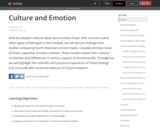
Text and links to all ancillary materials for Module 34
- Subject:
- Psychology
- Social and Behavioral Sciences
- Material Type:
- Module
- Reading
- Teaching/Learning Strategy
- Author:
- Jeanne Tsai
- Date Added:
- 05/31/2021

Text and links to all ancillary materials for Module 34
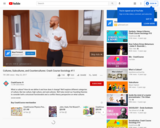
What is culture? How do we define it and how does it change? We’ll explore different categories of culture, like low culture, high culture, and sub-cultures. We'll also revisit our founding theories to consider both a structural functionalist and a conflict theory perspective on what cultures mean for society.
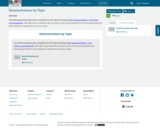
The following demonstrations were compiled from MIT OpenCourseware (MIT OpenCourseWare | Free Online Course Materials). Although they are labeled as demonstrations, they may be adjusted to be used appropriately for exam questions, assignments, discussion topics.
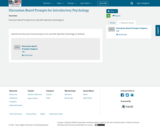
Discussion Board Prompts to be used with OpenStax Psychology 2e.
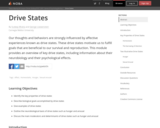
Text and links to all ancillary materials for Module 30
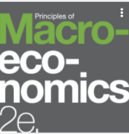
Test and Question Bank for OpenStax Course ECON.2311 Macroeconomics in Word and TestGen format.

Thie is the framework for a 16 week course.
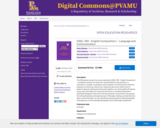
This OER packet contains the course materials for ENGL 1301 - English Composition I . In academic settings, the reasons for writing fulfill four main purposes: to summarize, to analyze, to synthesize, and to evaluate. You will encounter these four purposes not only as you read for your classes but also as you read for work or pleasure. Because reading and writing work together, your writing skills will improve as you read. Eventually, your instructors will ask you to complete assignments specifically designed to meet one of the four purposes. As you will see, the purpose for writing will guide you through each part of the paper, helping you make decisions about content and style. For now, identifying these purposes by reading paragraphs will prepare you to write individual paragraphs and to build longer assignments.
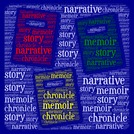
These materials will assist instructors with preparing students to write a narrative essay.
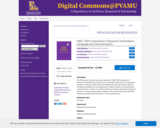
This OER packet contains the course materials for ENGL 1302 Composition II Research and Analysis that introduce you to the ways in which the act of writing has the power to help you make connections between yourself and the world. Writing can help you establish your own experiences or ideas in relation to the experiences or ideas of others. In short, it can help you figure out what you think about things and help you to situate those thoughts in relation to the world and among the multitude of opinions and ideas that exist within it. That’s a powerful tool.
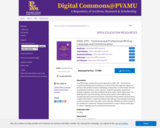
This OER packet contains the course materials for ENGL 2311 - Technical and Professional Writing that introduce you to some of the most important aspects of writing in the worlds of science, technology, and business—in other words, the kind of writing that scientists, nurses, doctors, computer specialists, government officials, engineers, and other professionals do as a part of their regular work. The skills learned in technical writing courses can be useful in other fields as well, including education and social sciences. Technical writing involves communicating complex information to a specific audience who will use it to accomplish some goal or task in a manner that is accurate, useful, and clear. Whether you write an email to your professor or supervisor, develop a presentation or report, design a sales flyer, or create a webpage, you are a technical communicator.
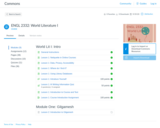
This is a World Literature I course that utilizes open educational resources that are embedded in the online course.

These are documents and links for an ENGL 1301 OER course.

From the original OER:
Introduction to Principles and Practices of Teaching Young Children
We are so excited you have decided to join us on your journey into the wonderful world of young children!
If you are reading this, you’re likely interested in learning more about becoming an early childhood professional. Perhaps you’re just curious and want to know a little bit more about young children. Maybe you want to make up your mind after finding out a little bit more about what is involved. In either case, your interest and curiosity are two key characteristics that will make this a positive growth experience for you.
You probably had other options but made coming to this class a priority. You care about children. You have an audacity of kindness and passion for teaching. Adhering to these qualities is the launching pad for successful early childhood professionals.
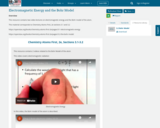
This resource contains two video lectures on electromagnetic energy and the Bohr model of the atom.This material corresponds to Chemistry Atoms First, 2e sections 3.1 and 3.2https://openstax.org/books/chemistry-atoms-first-2e/pages/3-1-electromagnetic-energyhttps://openstax.org/books/chemistry-atoms-first-2e/pages/3-2-the-bohr-model
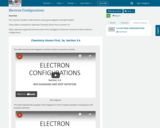
This resource includes 4 video lectures covering box diagrams and spdf notationThese videos correspond to OpenStax Chemistry Atoms-First 2e section 3.4https://openstax.org/books/chemistry-atoms-first-2e/pages/3-4-electronic-structure-of-atoms-electron-configurations
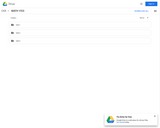
This google drive has notes for an Elementary Statistics I course. The chapter and sections numbers correspond to the OER textbook by Openstax, Introductory Statistics.
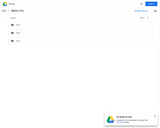
This google drive has notes for an Elementary Statistics II course. The chapter and section numbers correspond to the OER textbook by Openstax, Introductory Statistics.
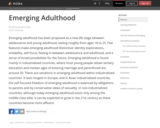
Text and links to all ancillary materials for Module 27
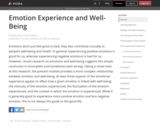
Text and links to all ancillary materials for Module 32